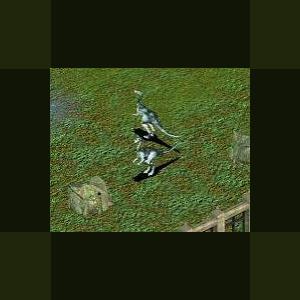About This File
Tro-odon (or Troödon) was a relatively small, bird-like dinosaur from the Late Cretaceous Period (75-65 mya). Discovered in 1855, it was among the first dinosaurs found in North America.
Its name (pronounced "Tro-odon") is Greek for "wounding tooth", referring to the
dinosaur's serrated teeth (although these may actually have been adapted for a herbivorous
diet). They were formerly known as saurornithoidids. Troodon was a small dinosaur, around 2 meters (6.5 ft) in length, 1 meter (3 ft) tall, and
weighed 60 kilograms (130 lb). It had very long, slender limbs, suggesting that the animal was able to move quickly. It had long 'arms' that folded against the wall of the thorax like a bird's. It had large, retractable sickle-shaped claws on its second toes, which were raised off the ground when running. Because of these features scientists regard
Troodon as a member of the Maniraptora. Its eyes were large (perhaps suggesting nocturnal
activity) and slightly forward facing, giving Troodon some depth perception. In fact most reconstructions give Troodon eyes which point in a more forwards direction than almost any
other dinosaur, which implies that it had better binocular vision than most dinosaurs.
Their light skulls contained a capsule similar to those found in ostrich dinosaurs.
Troodon had one of the largest known brains of any dinosaur, relative to its body mass
(comparable to modern birds). Hence it is believed to have been one of the most intelligent dinosaurs, even more intelligent than mammals of that era. Eggs have also been discovered, in nests.
Troodon is known from the Judith River Formation and the upper Two Medicine Formation of Montana, the Judith River Group of Alberta, the Horseshoe Canyon Formation of Alberta, the
North Slope of Alaska, and in the famous Lance and heck Creek Formations of the USA. There
is some evidence that Troodon favored cooler climates, as it seems to have been particularly abundant



Recommended Comments
There are no comments to display.
Create an account or sign in to comment
You need to be a member in order to leave a comment
Create an account
Sign up for a new account in our community. It's easy!
Register a new accountSign in
Already have an account? Sign in here.
Sign In Now